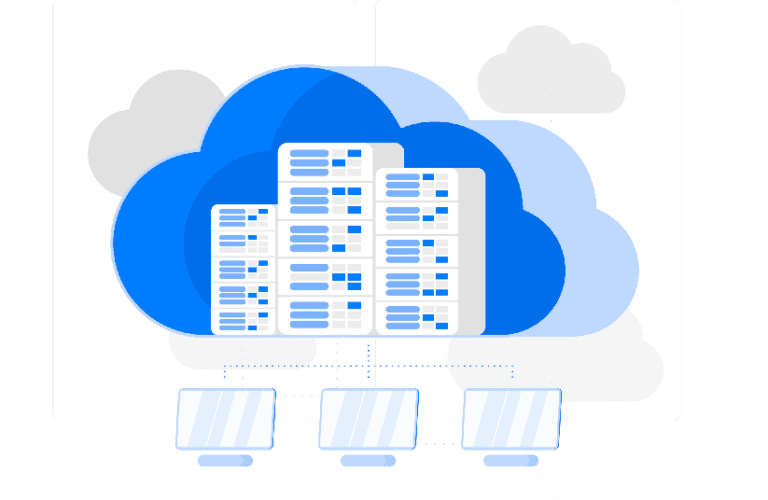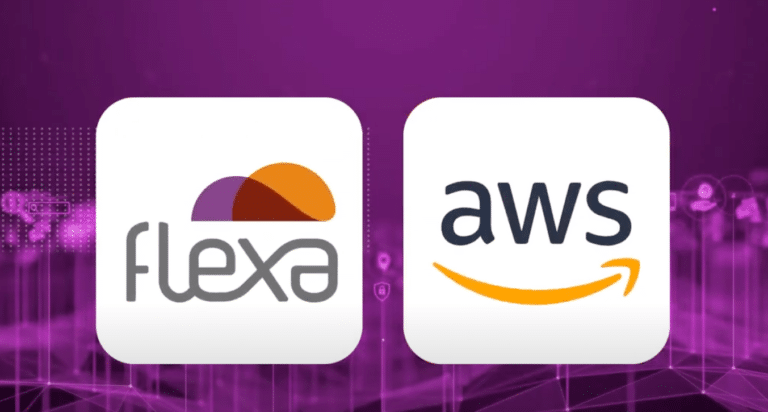More than 100 cloud computing products make up AWS. Together they provide storage, servers, networking, mobile development, email, security and more.
An example of AWS efficiency is as follows: AWS data centers are located all over the world in various regions. This provides greater disaster recovery. If one data center fails, another region can quickly pick it up.
Check below for a quick breakdown of the main services you will find within the AWS platform.
1. Computing
Here are the cloud computing services offered by Amazon:
- EC2 (Elastic Compute Cloud): a virtual machine in the cloud that you have operating system-level control over. You can run this cloud server whenever you want;
- LightSail: cloud computing tool that automatically deploys and manages the computer, storage and network resources needed to run your applications;
- Elastic Beanstalk: tool that provides automated deployment and provisioning of resources, such as a highly scalable production site;
- EKS (Elastic Container Service for Kubernetes): tool that allows you to orchestrate open source containers in Amazon's cloud environment without installation;
- AWS Lambda: service that allows you to perform functions in the cloud. The tool saves a lot for you to pay only when its functions are performed.
2. Migration
Migration services used to physically transfer data between the datacenter and AWS are:
- DMS (Database Migration Service): can be used to migrate on-premises databases to AWS. It helps you migrate from one type of database to another — for example, Oracle to MySQL;
- SMS (Server Migration Service): SMS migration services allow you to quickly and easily migrate on-premises servers to AWS;
- Snowball: a small application that allows you to transfer terabytes of data in and out of the AWS environment.
3. Storage
- Amazon Glacier: extremely cheap storage service. Offers fast and secure storage for archiving and backing up data;
- Amazon Elastic Block Store (EBS): provides block-level storage for use with Amazon EC2 instances. Amazon Elastic Block Store volumes are network-attached and remain independent of an instance's lifetime;
- AWS Storage Gateway: connects local software applications with cloud-based storage; provides secure integration between the on-premises enterprise and the AWS storage infrastructure.
4. Safety
- IAM (Identity and Access Management): cloud security service that helps manage users, assign policies, form groups to manage multiple users;
- Inspector: agent that you can install on your virtual machines, which reports any security vulnerabilities;
- Certificate Manager: offers free SSL certificates for your Route53 managed domains;
- WAF (Web Application Firewall): WAF security service provides application-level protection and lets you block SQL injection and helps block cross-site scripting attacks;
- Cloud directory: lets you create flexible cloud-native directories to manage data hierarchies across multiple dimensions;
- KMS (Key Management Service): managed service; helps you create and control the encryption keys that allow you to encrypt your data;
- Shield: managed by DDoS (Distributed Denial of Service Protection Service), provides safeguards against web applications running on AWS;
- soft: offers a data visibility security service that helps classify and protect your sensitive critical content;
- GuardDuty: offers threat detection to protect your AWS accounts and workloads.
5. Database
- Amazon RDS: database service that is easy to configure, operate, and scale a relational database in the cloud;
- Amazon DynamoDB: fast and fully managed NoSQL database service. It is a simple service that allows cost-effective data storage and retrieval. It also allows you to service any level of request traffic;
- Amazon ElastiCache: makes it easy to deploy, operate, and scale an in-memory cache in the cloud;
- Neptune: fast, reliable and scalable graphics database service;
- Amazon RedShift: Amazon's data warehousing solution that you can use to run complex OLAP queries.
6. Management
- CloudWatch: helps you monitor AWS environments such as EC2, RDS instances and CPU utilization. It also triggers alarms depending on various metrics.
- Cloud Formation: is a way of transforming cloud infrastructure. You can use templates to deliver an entire production environment in minutes.
- Cloud Trail: provides an easy method of auditing AWS resources. It helps you to record all changes.
- Opsworks: the service allows automated deployments of Chef/Puppet in the AWS environment.
- Config: this AWS service monitors your environment. The tool sends alerts about changes when you break certain defined settings.
- Service catalog: helps large companies authorize which service users will be used and which will not.
- AWS Auto Scaling: allows you to automatically scale your resources up and down based on provided CloudWatch metrics.
- Systems manager : this AWS service allows you to pool your resources. Allows you to identify problems and act on them.
- Managed Services: offers management of your AWS infrastructure, allowing you to focus on your applications.
7. Internet of Things
- IoT Core: is an AWS managed cloud service. The service allows connected devices such as cars, light bulbs, sensor grids to securely interact with cloud apps and other devices.
- IoT Device Management: lets you manage your IoT devices at any scale.
- IoT Analytics: This AWS IoT service is useful for performing analysis of the data collected by your IoT devices.
- Amazon FreeRTOS: This real-time operating system for microcontrollers helps to connect IoT devices on the local server or in the cloud.
11. Application
- Step functions: it's a way to visualize what's happening inside your app and what different microservices it's using;
- SWF (Simple Workflow Service): service that helps coordinate automated tasks and human-led tasks;
- SNS (Simple Notification Service): you may use this service to send notifications in the form of email and SMS based on the AWS services provided;
- SQS (Single Queue Service): use this AWS service to decouple your applications. It is a pull-based service;
- Elastic transcoder: this AWS service tool helps you change the format and resolution of a video to support various devices such as tablets, smartphones and laptops of different resolutions.
12. Deployment and Management
- AWS Cloud Trail: the services log AWS API calls and send backlog files to you;
- Amazon Cloud Watch: tools monitor AWS resources such as Amazon EC2 and Amazon RDS DB Instances. It also allows you to monitor custom metrics created by user applications and services;
- AWS CloudHSM: This AWS service helps meet corporate, regulatory, and contractual compliance requirements to maintain data security using Hardware Security Module (HSM) appliances within the AWS environment.
13. Development
- CodeStar: is a cloud-based service for creating, managing, and working with various software development projects on AWS;
- CodeCommit: is the AWS version control service that allows you to store your code and other assets privately in the cloud;
- CodeBuild: this Amazon developer service helps automate the process of building and compiling your code;
- CodeDeploy: is a way to deploy your code to EC2 instances automatically;
- CodePipeline: helps you create a deployment pipeline such as test, build, test, authenticate, deploy in development and production environments;
- Cloud9: is an integrated development environment for writing, running, and debugging code in the cloud.
14. Mobility
- Mobile Hub: lets you add, configure, and design features for mobile apps;
- Cognite: allows users to sign up using their social identity;
- Device farm: device farm helps you improve application quality by quickly testing hundreds of mobile devices;
- AWS AppSync: is a fully managed GraphQL service that offers real-time data synchronization and offline programming capabilities.
15. Business productivity
- Alexa for Business: empowers your organization with voice, using Alexa. This will help you build custom voice skills for your organization;
- WorkDocs: helps store documents in the cloud;
- WorkMail: allows you to send and receive business emails.
16. Desktop and Application Streaming
- Workspaces: it is a VDI (Virtual Desktop Infrastructure). It allows you to use remote desktops in the cloud;
- AppStream: a way to stream desktop apps to your users in the web browser. For example, using MS Word in Google Chrome.
17. Artificial Intelligence
- Lex: helps you build chatbots quickly;
- Polly: is AWS' text-to-speech service that lets you create audio versions of your notes;
- Recognition: is the face recognition service from AWS. This AWS service helps to recognize faces and objects in images and videos;
- Sage Maker: lets you build, train, and deploy machine learning models at any scale;
- Transcribe: is AWS' speech-to-text service that offers high-quality, affordable transcripts;
- Translate: tool very similar to Google Translate, which allows you to translate text from one language to another;
- Sumerian: is a suite of tools for delivering high-quality virtual reality (VR) experiences on the web. The service allows you to create interactive 3D scenes and publish them as a website for users to access.
18. Customer Involvement
- Amazon Connect: lets you build your customer service center in the cloud;
- Pinpoint: helps you understand your users and engage with them;
- SES (Simple Email Service): helps you send bulk emails to your customers at a relatively economical price.
What did you think of the AWS service and tool pool we've listed in this article? Go deeper into this topic, download our e-book now Migration to the AWS Cloud! or do contact us and see how we can help you!

















